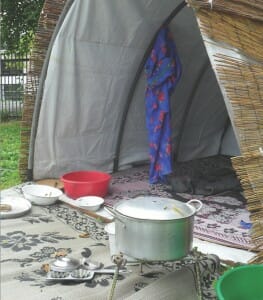
Tents set up on Citadel Hill. Photo by Paige Black.
When Doctors Without Borders member Leanne Olson stepped onto the makeshift model refugee camp on Citadel Hill Sept. 22 to 25, she immediately recalled her own experiences working in such camps abroad.
On a single workday in Liberia, she once administered 1,600 immunizations to children, protecting them from debilitating diseases. The work was exhausting, but she remembers the day with clarity.
On this workday though, she was part of the makeshift refugee camp set up on the Garrison Grounds on Citadel Hill by Doctors Without Borders, an international, independent, medical humanitarian relief organization. The camp gave attendees a chance to experience the realities of living in a war-torn country.
There are 42 million people in camps like this worldwide.
Doctors Without Borders is a professional organization without attachments. “It’s not religious, not political. It’s a human organization,” says Olson when asked why she works with Doctors Without Borders. “They have the resources and they don’t just get the job done, they get it done well.
“I believe that someone in a camp in the Sudan should have access to the same care someone walking into a clinic in Halifax does.”
Visitors were invited to take a guided tour by one of experienced volunteers, such as Olson, who has most recently worked as a part of the project in Liberia.
As this event tours the east coast they are met by local crews to help them get set up. Assigned to the job of volunteer co-ordinator for the Halifax stop was Dalhousie’s own Taq Bhandal, who is in her fourth year of her biology honors degree.
Beginning in July, she began to recruit volunteers who were willing to help the organizers run the event, many Dalhousie students stepped up to the plate with most from the international development department.
“I think the project is going to help resolve how desensitized society has become to seeing images like starving children,” Bhandal says. Through touring the site, she believes people will be able to make a connection from what they see in the media to what is happening in the field. Bhandal is involved in the UNICEF Society, is the president of the Heart and Stroke Foundation at Dalhousie and has recently started a blog, ‘Dalhousie Vocaleyes,’ which is designed to promote humanitarian issues.
The gate at the entrance to the reconstruction may be rather simple to hop over, but as Olson explains, it represents how a gate in a refugee camp is an important feature. In some war torn countries, military personnel, government, or rebel forces will try to enter the camps to recruit refugees to fight for their cause. Guards with guns line the fences around the camps to help protect those who have fled from violence.
When refugees arrive, shelter is the first priority. The refugees are given plastic and must find wood to build a makeshift structure. The shelter will not be very large and will house an entire family, uncomfortably. Olson says once the camp becomes more stable, refugees would end up moving into larger tents.
“Do the 15 of you know each other? Do you come from the same village? Do you practice the same religion?” she asks a group.
Olson says the tents would be kept for multiple families, who likely do not know each other. Privacy is a luxury and in a situation like this where thousands of people are displaced, it’s not something that can be afforded to anyone, she said, possibly for months or even years.
In a real refugee camp, once shelter has been taken care of, people will be looking for food, she says. When the camp first opens, BP-5 will be distributed. This compact emergency food, in bar form, contains 255 calories and the highest possible amount of nutritional value to volume ratio.
Olson explains to the group that large bags of rice and beans will eventually be delivered to the camp and handed out to families on a monthly basis. If residents are lucky there will be some cooking oil or maybe corn, but items like this run out frequently. If people get tired of rice and beans they will have to become resourceful to find anything different. Trading is an option if they have anything they are willing to give up.







